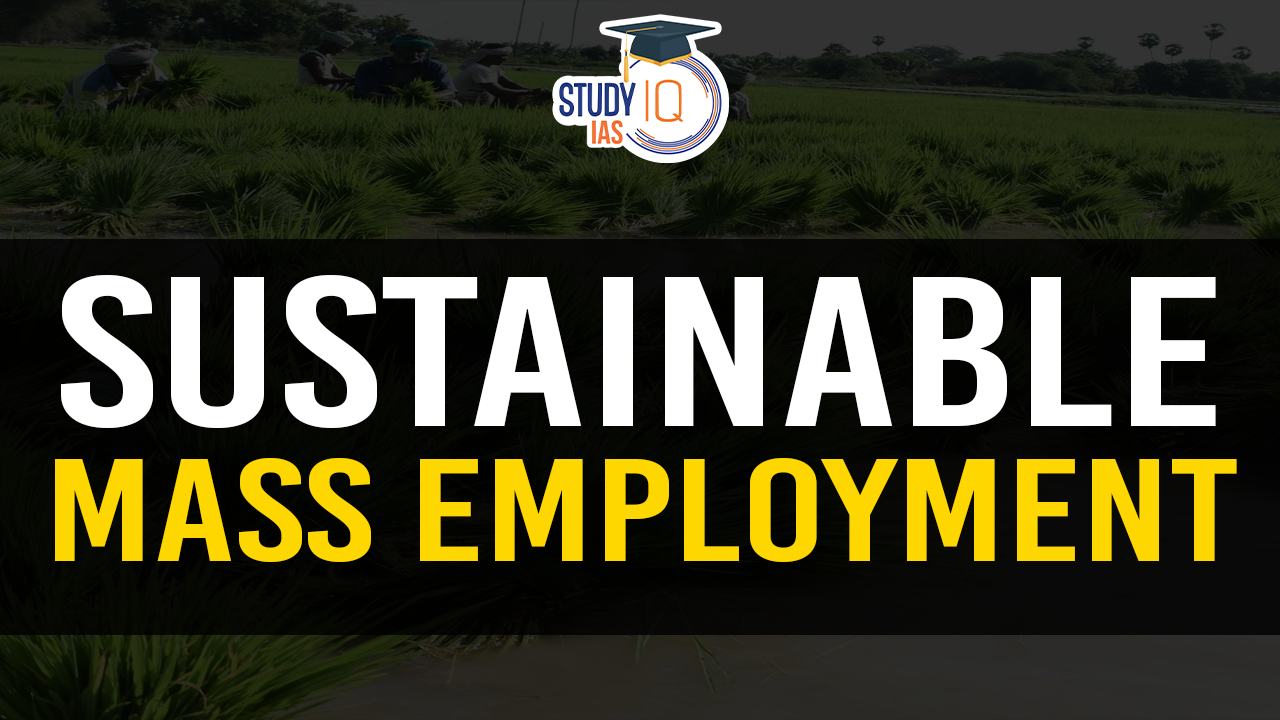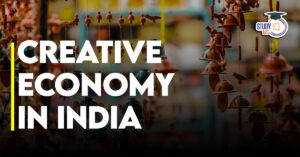Table of Contents
India, despite its rapid economic growth, faces a significant challenge in providing sustainable employment opportunities for its vast population.
What is Meant by Sustainable Employment?
Sustainable employment is the ability of the employee to provide added value for an organisation now and in the future, while also experiencing added value themselves.
- Or in simpler words, it is the commitment to long-term job security, fair wages, and healthy working conditions while supporting employees’ personal and professional development.
Components of Sustainable Employment
- Promote Fairness on Wages and Technology:
- Ensuring equitable wages for workers in line with their skills and contributions.
- Integrating technology in ways that enhance job quality and productivity without displacing workers unfairly.
- Provide Flexibility and Protection:
- Offering flexible work arrangements to meet the diverse needs of the workforce.
- Ensuring that workers have adequate protection, including job security and safe working conditions.
- Deliver on Health and Well-being:
- Focusing on the physical and mental health of employees.
- Providing benefits and support systems that contribute to the overall well-being of the workforce.
- Foster Employability and Learning Culture:
- Promoting continuous learning and skill development to keep employees competitive and adaptable in the job market.
- Encouraging a culture of lifelong learning within the organisation.
- Drive Diversity, Equity, and Inclusion:
- Ensuring a diverse workforce that includes people from various backgrounds and experiences.
- Promoting equity in opportunities and inclusion in workplace practices to build a more harmonious and productive environment.
- Environmental Sustainability:
- This includes promoting green jobs and ensuring that industries minimise their ecological footprint.
- Sustainable employment integrates practices that reduce environmental degradation and support the transition to a green economy.
Significance of Sustainable Employment
- Economic Stability and Growth: Sustainable employment is crucial for fostering long-term economic stability.
- It ensures that jobs are not only available but also offer fair wages and job security, which in turn supports consumer spending and economic growth.
- Example: Nordic countries have shown resilience during economic downturns by maintaining high employment rates and strong social safety nets.
- Social Equity and Inclusion: Reduces inequalities by providing fair opportunities for all, regardless of background.
- This includes equal pay for equal work and access to job opportunities for marginalised groups.
- Employee Well-being and Retention: A sustainable workforce model helps in retaining talent by addressing key employee needs, such as work-life balance, career development, and job security.
- This is particularly significant in the context of the “Great Resignation,” where many workers have left jobs that do not align with their personal needs or values.
- Sustainable employment practices, such as flexible working hours and ongoing education, enhance job satisfaction and reduce turnover
- Example: Recent SHRM research indicates that 64% of Indian workers are likely to stay with their employers if provided with a good organisational culture.
- Innovation and Productivity: Encourages a culture of continuous learning and adaptation, which is essential for innovation.
- Example: Infosys’s Digital Skills Training Program has helped Infosys maintain its competitive edge by equipping its workforce with the necessary skills to handle emerging technologies
- Environmental Impact: Jobs that are aligned with sustainable practices help preserve the environment, ensuring that economic activities do not deplete the natural resources needed for future employment and economic stability.
Challenges Associated with Sustainable Employment in India
- High Informal Employment: A substantial portion of India’s workforce, almost 82% of the workforce is engaged in the informal sector, and nearly 90% is informally employed, which is characterised by low wages, lack of job security, and absence of social benefits.
- Example: Gig workers often face issues such as job insecurity, irregular wages, and the absence of social protection, making it difficult for them to achieve economic stability and career progression.
- Skill Gap and Training: Despite a massive potential workforce, a substantial portion lacks the necessary skills demanded by modern industries.
- Example: Kerala has a highly educated labour force (30% of the labour force are graduates) and faces high unemployment due to mismatching and lack of required skills.
- Workplace Burnout: According to a 2023 survey conducted by the McKinsey Health Institute, a staggering 59% of Indian employees reported experiencing symptoms of burnout, the highest percentage globally.
- This issue is particularly pronounced among young workers and non-managers, with 62% of them reporting severe workplace exhaustion.
- Limitations of Short-Duration Skill Programs: Often fail to provide long-term employment, partly due to low wages that do not support a dignified life in urban areas.
- States like Odisha, despite pushing short-duration skilling programs, have low per capita consumption due to the lack of robust educational and vocational opportunities.
Policy Initiatives for Sustainable Mass Employment
- Decentralised Community Action for Skilling: Identify skilling needs through community involvement, with gram sabhas or basti samitis playing a critical role.
- Develop a personalised employment plan for every youth, in partnership with professionals at the cluster level.
- Apprenticeships should be based on community connections for transformational results.
- Convergence of Initiatives: Integrate education, health, skills, nutrition, livelihoods, and employment initiatives at the local government level, involving women’s collectives.
- Ensure community accountability and effective outcomes through the use of untied funds and functionaries.
- Vocational Courses in Colleges: Introduce need-based vocational courses alongside traditional undergraduate programs in every college.
- Resources should be provided to colleges for experimentation, as seen in some Mumbai colleges offering courses like tourist guiding and counselling.
- Standardisation of Health Care Training: Standardise nursing and allied healthcare professional courses to international benchmarks to improve employability both in India and abroad.
- Community Cadres of Care-Givers: Create community cadres to manage crèches, enabling women to work without fear.
- Draw inspiration from models like the Community Resource Persons of the Rural Livelihood Mission.
- Invest in ITIs and Polytechnics: Develop ITIs and polytechnics as skill development hubs for feeder schools, with a focus on States and districts lacking institutional vocational education structures.
- Enterprise and Start-Up Skills in Schools: Introduce technology and enterprise subjects in upper primary and high schools, with professionals imparting finishing skills.
- Co-Sharing Apprenticeships: Implement a co-sharing model of apprenticeships between the government and industry to ensure relevant skill development and job placement.
- Streamline Capital Loans for Women-Led Enterprises: Address challenges in accessing working capital loans, using technology and innovative credit solutions to scale women-led and first-generation enterprises.
- Universal Skill Accreditation Programme: Start a universal skill accreditation program for institutions, with joint state and industry sponsorship for candidates.
- Utilise MGNREGA Funds: Use 70% of MGNREGA funds in 2,500 water-scarce and deprived blocks, focusing on the poorest 20 families for livelihood security and productivity enhancement.
- Scale Up Apprenticeships: Increase the scale of apprenticeships, focusing on skill acquisition and ensuring that employer subsidies are tied to dignified wages upon successful completion.
Conclusion
- A roadmap for sustainable mass employment must focus on community-driven skilling, convergence of initiatives, educational reforms, and a strong role for the state in ensuring dignified wages and quality public goods.
- The integration of these initiatives will lead to higher productivity, better human development outcomes, and a higher quality of life for workers across India.


 Top 10 Economies in the World 2025, Chec...
Top 10 Economies in the World 2025, Chec...
 Minors Bank Account above 10 Years: Chan...
Minors Bank Account above 10 Years: Chan...
 Creative Economy in India, Current Situa...
Creative Economy in India, Current Situa...





















